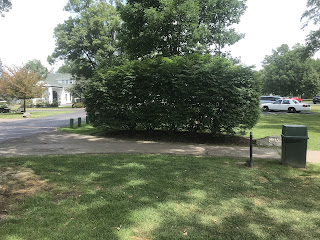 |
| Incrediball hydrangeas in full bloom by patio |
Tropical heat has descended upon the Cincinnati area. The last couple weeks have introduced multiple thunderstorms and very high humidity. This is good for keeping adequate moisture in the root zone for the cool season turfgrass, but it has its drawbacks. High humidity is a recipe for many turf diseases to take hold. When night time temperatures reach 70 degrees with daytime temperatures above 85, Pythium blight (one of the worst summer diseases) becomes a concern. Brown patch, anthracnose, and dollar spot are other diseases that thrive in this environment. To combat this we have been increasing our fungicide applications. They are not 100% effective at controlling outbreaks but with timely sprays we can greatly reduce disease presence.
 |
| Dollar spot on the chipping green collar |
Frequent rains and high humidity also negatively affect green speeds. Our data is showing that on days with high moisture the stimpmeter readings can be lowered by as much as a foot. Please understand that when a good amount of moisture is present, whether from rainfall or humidity, green speeds will be reduced. We will continue with our rolling frequency and once the humidity levels return to normal, the speeds will increase. For more information about green speed click here for a previous post.
With the heavy downpours bunker washouts become an issue. After a heavy thunderstorm many bunker faces wash out and it takes a 2 man crew a whole day to plow and rake the bunkers back into shape. Over the last couple of years we have been eliminating some of the problem bunkers and replacing others with a bunker without a steep bank. Also, the storms have produced an abundant amount of debris cleanup work.
 |
| #12 green bunker washed out after a thunderstorm producing 1.5" of rain |
 |
| debris after a thunderstorm |
 |
| debris after a thunderstorm |
 |
| #17 valley resembling the whitewater river |
 |
| #13 green draining the way the architect designed |
 |
| Broken tree branches on the ground and hanging in the catalpa tree by #9 fairway after a storm |
This season the Grounds team has been accumulating data to help with agronomic practices. One of the areas that we are measuring are the nitrogen applications. It has allowed us to pin point how much nitrogen we have been applying and make necessary changes throughout the season. On the fairway spray applications we are increasing the nitrogen input to offset some diseases, improve color, and help with recovery from increased cart traffic. We will continue to monitor and make corrections as the season progresses.
 |
#16 fairway showing an emerald green color after a nitrogen application |
The burning bushes adjacent to #12 cart path have been removed. This will help with safety for cars and carts traveling in that area and help with the aesthetics, allowing the new guinea impatien bed to be more visible when entering the club.
 |
| Burning bushes before removal |
 |
| Area after bushes removed with new bed of crotons by #12 tee |
There are swales and uneven areas in the fairways that we have been raising and leveling. Low/uneven spots on #2, #4, #13, #12, #15, and #18 were rectified earlier in the year. The large swale located to the left on #11 was recently fixed. The sod was excavated, dirt added, leveled off, and sod placed back on. The area should heal back in the next couple of weeks.
The new landscape beds located by #11 green and by #13 tee are filling in nicely. The swamp milk weed is attracting monarch butterflies. Many pollinator insects are being attracted to the other perennial flowers as well.
 |
| A monarch butterfly enjoying the cinderella swamp milkweed |
 |
#11 landscape bed |
An interesting disease is occurring on many pear trees around the tri-state. It is called cedar-quince rust and it leaves orange dust underneath the tree canopy. It is very noticeable on side walks and driveways and even garnered enough attention to became a segment on the local news. The wet and humid conditions that are occurring have created an environment for this disease to thrive. Orange spores on the fruit produces the Cheeto like dust. To read more about this disease click here.
 |
Cedar-quince rust on the pear fruit on #18 |
If a typical Cincinnati summer is ahead we should be trading in these tropical conditions for a drought sometime in August into September. In the mean time, we will adjust our agronomic practices for a tropical rainforest climate and give the irrigation system a respite before the dry heat returns.
Brad Piecuch
Grounds Superintendent


No comments:
Post a Comment
Note: Only a member of this blog may post a comment.